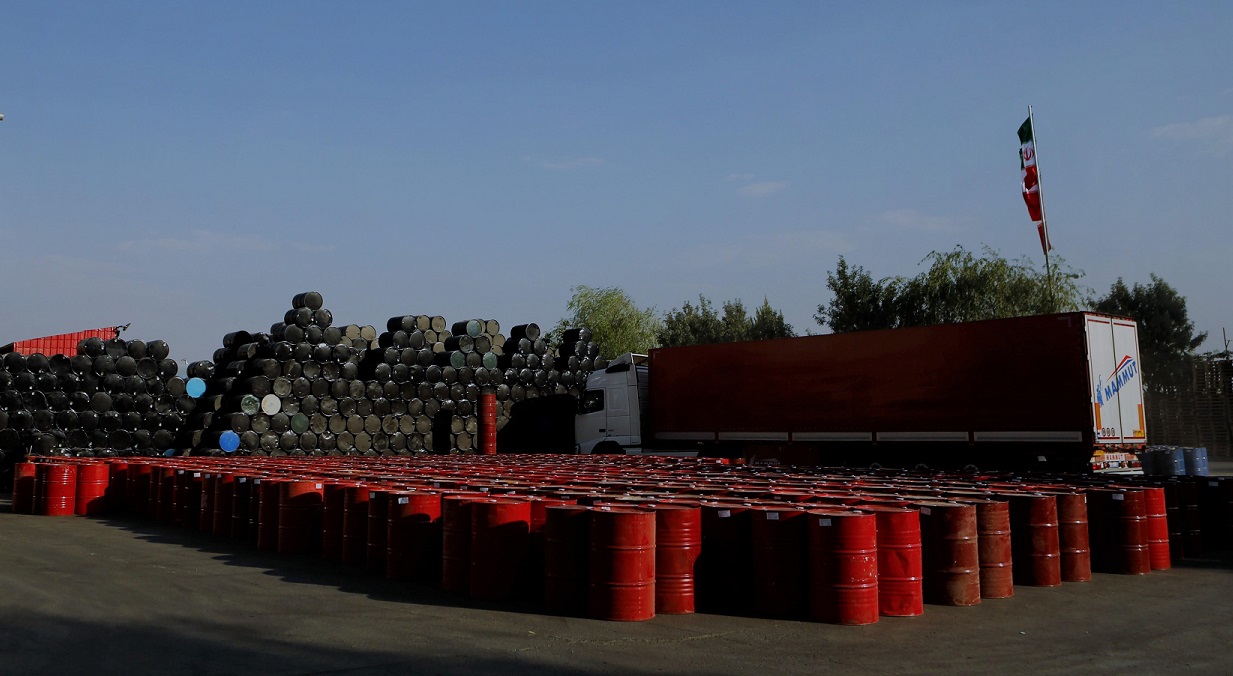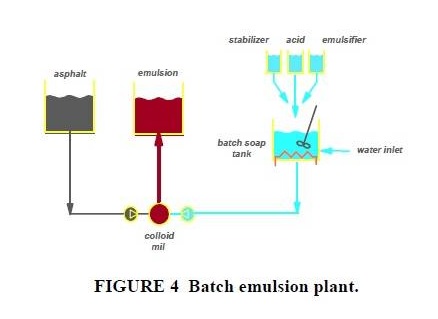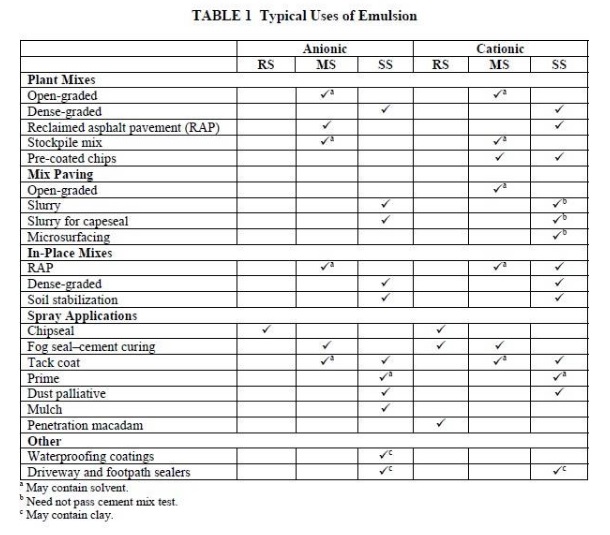
Emulsion Bitumen

Introduction of Emulsion Bitumen
Emulsion Bitumen have being developed and exponentially increased sinned they were created in 1900. Estimated presently at 20% of the global bitumen use, Emulsion Bitumen are basically an O/W – Oil on Water solution – A dispersion of bitumen particles in water, stabilized with the addition of surfactants – Surface active agents – or most commonly known as emulsifiers, that will permit the bitumen to de diluted in water. They are primarily used for tack coats for use in between hot mix asphalt layers and prime coats for thin hot mix surfacing layers or a chip seal pavement.
Emulsion Bitumen are divided into three categories:
- Anionic with negatively charged globules
- Cationic with positively charged globules
- Non-ionic with neutral globules.
The main grades for emulsion bitumen are classified as follows:

Emulsion Bitumen is an area where technological progress is still being made to meet the requirements of pavement engineering. Anionic emulsions were first developed. They are currently less favored than the cationic emulsions, as cationic emulsions coat the aggregates more efficiently due to their positive load and have therefore better adhesion properties. Cationic Emulsion is both more favored and more widely used.
Emulsified Bitumen usually consists of bitumen droplets suspended in water. This dispersion under normal circumstances would not take place since everyone knows that oil and water don’t mix, but if an emulsifying agent is added to the water the asphalt will remain dispersed. Most emulsions are used for surface treatments. Emulsions enable much lower application temperatures to be used. Application temperatures range from 45°C to 70°C. This is much lower than the 150 to 190°C used for hot mix asphalt cement. The lower application temperatures will not damage the asphalt and are much safer for field personnel.
In the production of emulsion bitumen , water is treated with an emulsifying agent and other chemicals and is pumped to a colloid mill along with bitumen. The colloid mill breaks the bitumen up into tiny droplets. The emulsifying agent migrates to the asphalt-water interface and keeps the droplets from coalescing. The emulsion is then pumped to a storage tank.
Emulsion Bitumen is complicated and good chemistry is required to reach target desired emulsion properties. Variables in emulsion production include the base bitumen and the type and amount of emulsifying agent. There are two basic classifications of emulsions globally usually used, anionic bitumen emulsions and cationic bitumen emulsions. The type (chemistry) of the emulsifying agent used, determines the designation. Emulsifying agents are the chemicals used to stabilize the emulsion and keep the “billions and billions” of bitumen drops separated from one another. These compounds are large organic molecules that have two distinct parts to them. These parts are called the “head” and “tail.” The “head” portion consists of a group of atoms that chemically have positive and negative charge areas. These two charged areas give rise to the head being called polar (as in poles of a magnet). Because of this polarity, and the nature of some of the atoms in this polar head, the head is soluble in water. The tail consists of a long chain organic group that is not soluble in water but is soluble in other organic materials like oils (bitumen). Thus, an emulsifying agent is one molecule with both water-soluble and oil-soluble portions. This unique characteristic gives the chemical its emulsifying ability.
Breaking Characteristics of Emulsion Bitumen
Emulsions exist for ease of application. After application, the water to should evaporate and leave the asphalt cement. In a surface treatment, after emulsion and aggregate have been applied to the road surface, the emulsion should “break” leaving the asphalt cement holding the aggregate. At that point, traffic may be allowed on the surface without loss of aggregate. The type of emulsion used has a large effect on the speed of the “break” of an emulsion.
Almost all surfaces have a net negative charge. The strength or intensity of this negative charge may be different from material to material. Because of this phenomenon, anionic and cationic emulsions break in different ways.
In an application of anionic emulsion, negatively charged drops of asphalt are applied to a negatively charged surface. All components repel each other. The only way the emulsion can break is through the loss of water by evaporation. As more and more water is lost through evaporation, the particles are forced closer and closer together until they can no longer be separated by a film of water. At this point, droplets coalesce into larger and larger drops and ultimately a sheet of asphalt on the road.
In an application of cationic emulsion, we are applying positively charged drops of bitumen to a negatively charged surface. The bitumen drops are immediately attracted to the surface and begin to break. The emulsion also loses water by evaporation. Thus the cationic emulsion has two breaking mechanisms at work and will break faster than a corresponding anionic emulsion.
The object of a surface treatment is to seal the road from moisture intrusion and provide a new skid resistant surface, but be open to traffic as soon as possible and retain aggregate. Due to the chemistry of emulsions, they may react differently in specific weather and application conditions. If you have problems in any of these areas, the problem could be because of the weather, aggregate condition or emulsion used.
In bitumen emulsions, the basic bitumen has also been diluted in order to facilitate application. Hot bitumen, water, and emulsifier are processed in a high-speed colloid mill that disperses the bitumen in the water. The emulsifier produces a system in which fine droplets of bitumen, of between 30% and 80% of the volume, are held in suspension. If they separate in storage, the emulsion can easily be restored by agitation.
Bitumen emulsions have a low viscosity and can be workable at ambient temperatures, which makes them ideal for use in road pavements and surfacing. This application requires controlled breaking and setting. The emulsion must not break before they are laid on the road surface but, once in place, they should break quickly so that the road can be in service again without delay.
Bitumina supplies and provides transfer of technology for production of both Anionic & Cationic Bitumen Emulsions in correspondence to ASTM D977-12 and EN 13808-2005. For any inquiries, please contact our sales team on info@rahabitumen.com
Emulsion Bitumen Usage in Prime and Tack Coat
TACK COAT:
What is tack coat?
Tack coat (also known as the bond coat) is a light application of asphalt emulsion between hot mix asphalt layers designed to create a strong adhesive bond without slippage. Heavier applications may be used under porous layers or around patches where it also functions as a seal coat.
Applying one layer of bitumen emulsion between surface below the road and the road surface which results to stick two layers and avoids slipping on each other. Cationic Rapid Set (CRS) or Cationic Slow Set (CSS) type of bitumen emulsion are used for this application.
Why use tack coat?
Without tack coat, the asphalt layers in a roadway may separate which reduces the structural integrity of the road and may also allow water to penetrate the structure
What type of emulsion should be used for tack coats?
The type of emulsion used for tack coats varies from country to country. Normal practice in the USA is to use a slow-setting emulsion that is diluted with water before application. In many European countries cationic rapid setting or specially designated low viscosity medium setting emulsions are used, which are applied undiluted.
- Tack Coat applications and facts:
- This application is necessary to stick two asphalt layers together.
- Preventing the layers from slipping on each other.
- Only 500 to 800 grams of bitumen emulsion is needed to pave per square meter.
- By applying Tack Coat, two layers act as one result in terms of consistency and stability.
- It is cost efficient with respect to the other approaches.
PRIME COAT:
Why use prime coat?
Prime coats protect the integrity of the granular base during construction and help reduce dust. In the case of a base which is to be covered with a thin hot mix layer or a chip seal for a low volume roadway, priming ensures a good bond between the seal and the underlying surface which otherwise would have a tendency to delaminate.
Implementation of a layer of bitumen emulsion on the base which prepares the base for performing another asphalt layer on it. Cationic Slow Set (CSS) type of bitumen emulsion is used for this application.
Why use asphalt emulsion prime?
Compared to cut back asphalt primes, emulsion primes are environmentally friendlier.
What type of emulsion is most suitable for emulsion prime?
- Slow-setting grades of asphalt emulsions (diluted with water before application) are suitable. With dense granular bases, or stabilized bases the surface may need to be broken up by scarifying before application, to ensure good penetration.
- Prime coat applications and facts:
- It penetrates to the base layer. It acts like a glue to the material of the base and binds them to each other.
- It makes the base layer hard and tough. It also makes the base layer water proof and acts as a seal by filling the voids and cavities.
- It sticks base layer and asphalt layer implemented on it.
- Only 1.1 kg of bitumen emulsion is enough to apply per square meter whereas cutbacks must be paved 1.3 to 1.8 kg per square meter.
- If the road has water hole or is water saturated, surface, prime coat must not be applied until water is removed.
- It is better to pave a water layer on the base surface for better penetration of prime coat.
- After 48 hours, the first asphalt layer must be applied.
- The application has low cost.

Use of Emulsion Bitumen
The first asphalt (bitumen) emulsions used in road construction were prepared in the early part of the 20th century. Today approximately 3 million tons of emulsions are produced in the United States representing about 5% to 10% of asphalt consumption. More than 8 million tons of emulsions are produced worldwide. Emulsion production varies greatly among countries with the United States, France, Mexico, and Brazil being significant producers.
ADVANTAGES OF EMULSION
With viscosities in the range 0.5–10 Poise at 60°C, asphalt emulsion is of considerably lower viscosity than asphalt itself (100–4,000 Poise), allowing it to be used at the lower temperature. Low-temperature techniques for construction and maintenance reduce emissions, reduce energy consumption, avoid oxidation of the asphalt, and are less hazardous than techniques using hot asphalt. They are also more economical and environmentally friendly than cold techniques using cutback asphalts. The environmental benefit of asphalt emulsion is particularly positive when used for in-place or on-site techniques which avoid the energy usage and emissions associated with heating, drying, and haulage of aggregate. The construction of a roadway with cold techniques has been calculated to consume approximately half the energy of one of similar bearing capacity made with hot-mix asphalt (HMA). An environmental impact analysis (EIA) technique called “eco-efficiency” has been applied to emulsion maintenance techniques (micro surfacing and chip seal) and it was concluded that the emulsion system had less environmental impact than a thin hot-mix overlay.
Emulsions are water-based and in many cases can be diluted further with water for applications such as dust control and priming. They are also compatible with hydraulic binders like cement and lime as well as water-based polymer dispersions like natural and synthetic latex.
When mixtures of cement, latex, and asphalt emulsion cure, a composite binder is produced with a structure that cannot be duplicated with hot asphalt and with significantly improved properties compared to pure asphalt.
Testing Emulsion
Emulsion testing will be addressed in detail in another paper. Most test methods have been accepted as ASTM standards. The tests fall into three groups: those that test the handling properties of the emulsion, such as residue content, viscosity, and storage stability sieve residue; those that classify the emulsion into rapid-, medium-, or slow-setting grades, such as demulsibility, cement mix test, and coating tests; and tests on the residue recovered by evaporation, such as penetration or ductility. The emulsion may then be subject to additional performance tests related to the particular application of the emulsion in cold mix, chip seal, etc., using job aggregates.
EMULSION APPLICATIONS
Applications will be addressed in detail in other papers. Some typical applications of the various grades of the emulsion are summarized in Table 1, but local practice varies considerably. The choice of emulsion for each application is a question of matching the reactivity of the emulsion with the reactivity of the aggregate and the environmental conditions. Aggregate reactivity is mostly associated with the very finest-size fractions which make the highest contribution to the surface area.
So a reactive RS emulsion is used with the low-surface area unreactive aggregates used in chip seal, whereas a low-reactive SS emulsion would be used for a dense cold mix which has a high content of – 75 micron material and consequently high reactivity.
Environmental conditions also have to be taken into account. High temperatures accelerate the chemical reactions and physical processes involved in emulsion setting and therefore demand slower setting emulsions.
MANUFACTURE OF EMULSION
Emulsions are made by mixing hot bitumen with water containing emulsifying agents and applying mechanical energy sufficient to break up the bitumen into droplets. The effect of manufacturing variables on emulsion properties will be described in detail in a later paper.
It is clear that the manufacturing process can not only affect the physical properties of the emulsion but also affects the performance of the emulsion.
Emulsification is opposed by the internal cohesion and viscosity of the bitumen and the surface tension of the droplet which resists the creation of new interface. Smaller droplets are favored by a high energy input, a low bitumen viscosity at the emulsification temperature and by the choice and concentration of emulsifier (which reduces the interfacial tension). In the most common process, the emulsifier is dissolved in the water phase of the emulsion, and this water solution or “soap” is mixed with the hot liquid asphalt in a colloid mill (Figure 4).


